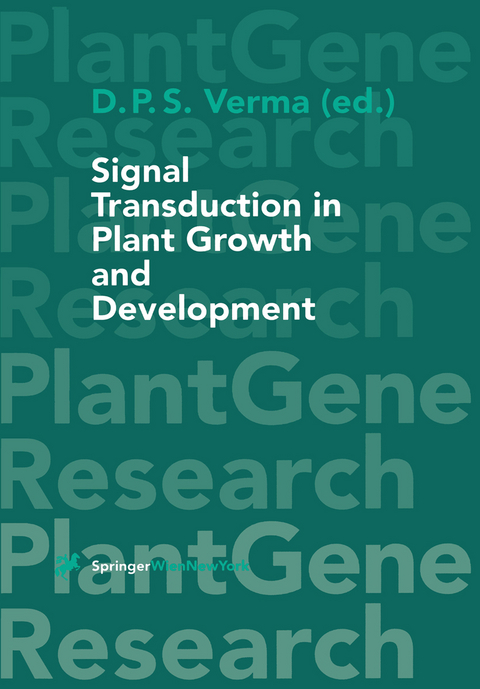
Signal Transduction in Plant Growth and Development
Springer Wien (Verlag)
978-3-7091-7476-0 (ISBN)
Signal Transducing Proteins in Plants: an Overview.- I. Introduction.- II. Signal Transduction Paradigm.- III. Conserved Signaling Proteins in Plants.- IV. Novel Plant Signaling Mechanisms.- V. Conclusions and Future Challenges.- VI. References.- G-Protein Regulation of Plant K+ Channels.- I. Introduction.- II. G-Protein Regulation of Animal Ion Channels: Background and Methodology.- III. G-Protein Regulation of Plant Ion Channels.- IV. Future Prospects.- V. References.- Metabolite Sensing and Regulatory Points of Carbon and Nitrogen Metabolic Pathways and Partitioning in Plants.- I. Introduction.- II. Global Regulatory Systems of Metabolic Pathways in Prokaryotes and Lower Eukaryotes.- III. Regulation of Carbon and Nitrogen Metabolism in Higher Plants.- IV. Future Prospects: Challenges for Metabolic Engineering of Crop Plants.- V. References.- Regulation of C/N Interactions in Higher Plants by Protein Phosphorylation.- I. Introduction.- II. Regulation of Key Cytosolic Enzymes by Reversible Phosphorylation.- III. Control of C/N Interactions.- IV. Conclusions.- V. References.- Phosphorylation and the Cytoskeleton.- I. Introduction.- II. Cytoskeletal Dynamics and Phosphorylation of the Polymer Proteins.- III. Phosphorylation of Cytoskeletal Associated Proteins During Interphase.- IV. Phosphorylation of Cytoskeletal Proteins During Cell Division.- V. Summary.- VI. References.- The Regulatory Phosphorylation of C4 Phosphoenolpyruvate Carboxylase: a Cardinal Event in C4 Photosynthesis.- I. Introduction.- II. C4 PEPC, a Highly Regulated Plant Enzyme.- III. Regulatory Phosphorylation of PEPC and Its Role in C4 Photosynthesis.- IV. Conclusions and Outlook.- V. References.- Salicylic Acid - an Important Signal in Plants.- I. Introduction.- II. Salicylic Acid in Thermogenesis.-III. Disease Resistance.- IV. Salicylic Acid as a Signal in Plant Defense.- V. Salicylic Acid as the Translocated Signal.- VI. Salicylic Acid Metabolism.- VII. Mechanisms of Action of Salicylic Acid.- VIII Salicylic Acid Signal Transduction Pathway.- IX. Perspectives.- X. References.- Biologically Active Lipids and Lipid-modulated Protein Kinase in Plants.- I. Introduction.- II. What Enzymes Do Generate Biologically Active Lipids in Animals and in Plants?.- III. Lipid-modulated Protein Kinase in Plants.- IV. References.- S-Loeus Receptor Kinase Genes and Self-incompatibility in Brassica napus.- I. Introduction.- II. Genetics of the Self-incompatibility System.- III. Molecular Biology of the Self-incompatibility System.- IV. Self-incompatibility in Brassica napus.- V. Self-compatibility in Brassica napus.- VI. Molecular Model for Brassica Self-incompatibility.- VII. Conclusion.- VIII. References.- Mechanisms of Input and Output in Circadian Transduction Pathways.- I. Introduction.- II. Rhythmic Outputs.- III. Interaction of Photoreceptors and Clocks.- IV. Conclusion.- V. References.- Role of Plasmodesmata and Virus Movement Proteins in Spread of Plant Viruses.- I. Introduction.- II. Plasmodesmata.- III. Virus Movement in Infected Plants.- IV. Conclusions.- V. References.- Ex-Planta and In-Planta Signals in Legume-Rhizobium Interaction.- I. Introduction.- II. Plant Flavonoid Signals and the Response of Rhizobia.- III. Synthesis of Nod Factors by Rhizobium.- IV. Other Rhizobial Signals Affecting Nodule Formation.- V. Signals Produced by the Host in Response to Nod Factors.- VI. Early Host Response to Bacterial Signals.- VII. Plant Phosphatidylinositol-3-kmase.- VIII. Endocytosis and Subcellular Compartmentation in the Host Cell.- IX. Conclusions.- X. References.
| Erscheint lt. Verlag | 26.10.2011 |
|---|---|
| Reihe/Serie | Plant Gene Research |
| Zusatzinfo | X, 318 p. |
| Verlagsort | Vienna |
| Sprache | englisch |
| Maße | 170 x 244 mm |
| Gewicht | 587 g |
| Themenwelt | Naturwissenschaften ► Biologie ► Botanik |
| Naturwissenschaften ► Biologie ► Zellbiologie | |
| Weitere Fachgebiete ► Land- / Forstwirtschaft / Fischerei | |
| Schlagworte | Bacteria • Development • growth • Phytohormon • Plant • Plant growth • plants • proteins • signal transduction |
| ISBN-10 | 3-7091-7476-7 / 3709174767 |
| ISBN-13 | 978-3-7091-7476-0 / 9783709174760 |
| Zustand | Neuware |
| Haben Sie eine Frage zum Produkt? |
aus dem Bereich


